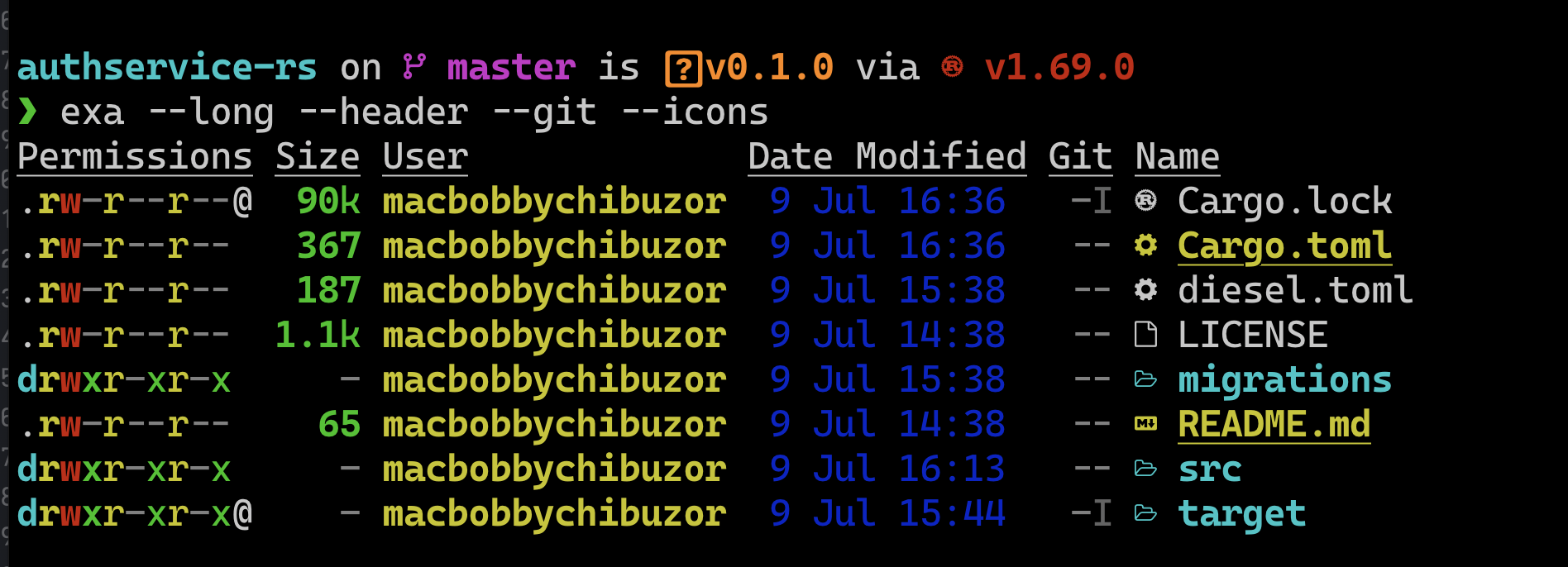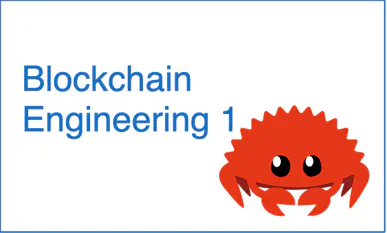Structuring a Rust Codebase - Exploring Rust's Module System for Code Organization
Table of Contents
Introduction
Structuring a Rust codebase can be so frustrating for beginners. I experienced this issues multiple times while starting out new projects in Rust. Typically, I default to the hexagonal architecture while building a web project in Golang, but replicating in Rust has not been exactly straight forward.
In this article, we will explore the Rust’s module system in detail. We will cover packages, crates and modules, and how best to structure them.

Adding visibility to components
When you start out building software that has different parts of services, you will probably create different folders to house specific services or parts.
Golang Example
In Golang for example, an authentication service codebase can look like (bare-bones project here ):
- authentication-service/
|- main.go
|- go.mod
|- api/
|- handlers.go
|- routes.go
|- authentication/
|- user.go
|- token.go
|- repository.go
|- service.go
|- storage/
|- database.go
|- utils/
|- encryption.go
The components (functions, custom types, etc.) in any folder can be used in another folder automatically when you define this components to have a capital initial. This is the visibility rule in Go. The routing service (api/routes.go) for the API has the following logic:
package api
import (
"github.com/gorilla/mux"
)
func SetupRouter() *mux.Router {
router := mux.NewRouter()
router.HandleFunc("/signup", SignupHandler).Methods("POST")
router.HandleFunc("/login", LoginHandler).Methods("POST")
return router
}
The entry point (main.go file) imports and uses the SetupRouter method in api/routes.go:
package main
import (
"github.com/theghostmac/authService/api"
"log"
"net/http"
)
func main() {
router := api.SetupRouter()
log.Fatal(http.ListenAndServe(":8080", router))
}
This works without any errors because of the visibility rule in Go. These folders are called modules, or tiniest units of software that can be executed or used by themselves.
A single source file can be a module, so we can actually put the routes.go file in the root directory and the SetupRouter() method will work as is, with little adjustments like:
- removing the unused import
“github.com/theghostmac/authService/api”, - renaming
package apitopackage main.
Now, I believe you’ve refreshed your memory on modules. Let’s see how this applies to Rust.
Rust implementation with Rocket
Say a Rust developer wants to recreate the authentication service with Rust, they would write all the functions and type declaration in the src/main.rs because it is easy to do so.
Writing tests in for a simple Rust function is as simple as scrolling down in that same source file and using the
#[test]compiler attributes.
However, from normal software engineering best practices, the Single Responsibility Principle in the SOLID principles teach that “each micro service should have a single responsibility or focus on one specific business capability.”
Having a standalone main.rs file handle the service would look like:
#[macro_use] extern crate rocket;
use diesel::prelude::*;
use std::env;
use rocket::response::status::Created;
use rocket::response::status::Unauthorized;
mod authentication {
use std::fmt::Error;
use super::*;
use diesel::PgConnection;
pub struct User {
pub id: i32,
pub username: String,
pub password: String,
}
impl User {
pub fn new(id: i32, username: String, password: String) -> Self {
Self {
id,
username,
password,
}
}
pub fn save(&self, connection: &PgConnection) -> Result<(), Error> {
use crate::schema::user::dsl::*;
let new_user = NewUser {
username: &self.username,
password: &self.password,
};
diesel::insert_into(users)
.values(&new_user)
.execute(connection)?;
Ok(())
}
pub fn delete(&self) {
// delete user
}
}
pub struct Token {
pub id: i32,
pub user_id: i32,
pub token: String,
}
impl Token {
pub fn new(id: i32, user_id: i32, token: String) -> Self {
Self {
id,
user_id,
token,
}
}
pub fn save(&self) {
// save token
}
pub fn delete(&self) {
// delete token
}
}
}
use authentication::*;
fn establish_connection() -> PgConnection {
Ok(dotenv());
let database_url = env::var("DATABASE_URL").expect("DATABASE_URL not set");
PgConnection::establish(&database_url)
.expect(&format!("Error connecting to {}", database_url))
}
#[post("/signup")]
fn signup_handler() -> Created<String> {
let connection = establish_connection();
let user = User::new(1, "username".to_owned(), "password".to_owned());
user.save(&connection);
Created::new("Signup successful".to_owned())
}
#[post("/login")]
fn login_handler() -> Result<&'static str, Unauthorized<()>> {
Ok("Login succesful")
}
#[launch]
fn rocket() -> _ {
rocket::build().mount("/signup", routes![signup_handler])
.mount("/login", routes![login_handler])
}
If you build and run it with cargo, it works. The only external module to be used would be the auto-generated migrations from diesel, the ORM and query builder for Rust. Let’s see how to use Rust modules to make this service more readable.
Modules in Rust
Modules in Rust are similar to those in Go. You can create custom modules (or folders, if you like) to serve different purposes. You can also leave single source files in the src/ directory of your Rust codebase to act as modules.
You will understand better when we refactor the main.rs file to into different modules (bare-bones project here
):
Create three directories inside of
src/calledmodules,entities, andrepositories. Create a submodule insidemodulesdirectory calledauthentication.Create three files:
user.rsinentitiesdirectory,authentication.rsinauthenticationdirectory undermodules, anduser_repository.rsinrepositoriesdirectory.Create a
mod.rsfile in the three directories. Addpub mod <file name without .rs extension>to themod.rsfiles, e.g. inentities, themod.rsfile while have onlypub mod user;in it. The codebase structure will look like:src/ ├── entities │ ├── mod.rs │ └── user.rs ├── main.rs ├── modules │ ├── authentication.rs │ └── mod.rs └── repositories ├── mod.rs └── user_repository.rsAdd the following code to each:
// user.rs pub struct User { pub id: i32, pub username: String, pub password: String, } impl User { pub fn new(id: i32, username: String, password: String) -> Self { Self { id, username, password, } } }// authentication.rs use crate::entities::user::User; use crate::repositories::user_repository::UserRepository; pub struct AuthenticationModule { user_repository: UserRepository, } impl AuthenticationModule { pub fn new(user_repository: UserRepository) -> Self { Self { user_repository } } pub fn signup(&self, user: &User) { // Perform signup logic self.user_repository.save(user); } pub fn login(&self, username: &str, password: &str) { // Perform login logic } }// user_repository.rs use crate::entities::user::User; pub struct UserRepository { } impl UserRepository { pub fn new(database_url: &str) -> Self { // Create and initialize the necessary database connection or ORM instance // For example, establish a Diesel connection to the database Self { // Initialize the fields here } } pub fn save(&self, user: &User) { // Implement the logic to save the user to the database // You can use Diesel or any other ORM/library here } pub fn delete(&self, user: &User) { // Implement the logic to delete the user from the database // You can use Diesel or any other ORM/library here } }Update the
main.rsfile with the following:#[macro_use] extern crate rocket; use diesel::prelude::*; use rocket::response::status::Created; use rocket::response::status::Unauthorized; use std::env; use dotenv::dotenv; mod entities; mod repositories; mod modules; use entities::user::User; use modules::authentication::AuthenticationModule; use repositories::user_repository::UserRepository; fn establish_connection() -> UserRepository { Ok(dotenv()); let database_url = env::var("DATABASE_URL").expect("DATABASE_URL not set"); UserRepository::new(&database_url) } #[post("/signup")] fn signup_handler() -> Created<String> { let connection = establish_connection(); let user = User::new(1, "username".to_owned(), "password".to_owned()); let authentication_module = AuthenticationModule::new(connection); authentication_module.signup(&user); Created::new("Signup successful".to_owned()) } #[post("/login")] fn login_handler() -> Result<&'static str, Unauthorized<()>> { Ok("Login succesful") } #[launch] fn rocket() -> _ { rocket::build() .mount("/signup", routes![signup_handler]) .mount("/login", routes![login_handler]) }
Putting it all together
Great! Now that we have discussed the necessary steps for creating new modules in our mini hexagonal application, let’s put everything together.
To recap, here are the key points:
The new modules should be placed inside the
src/directory.Each module should have a
mod.rsfile that exports the main module file. However, there are two alternative approaches you can take:Option 1: Directly create the module file under
src/: Instead of creating a separatemod.rsfile, you can create theuser.rsfile (or any other module file) directly under thesrc/directory. In this case, you would include the module using themodkeyword in your main application file (main.rs).For example, let’s assume we have a
usermodule. To include it in your application, you would add the following line in yourmain.rsfile:mod user;This approach eliminates the need for a separate
mod.rsfile, as the module file is directly placed in thesrc/directory.Option 2: Create a
mod.rsfile in the new module: Alternatively, you can create amod.rsfile within the new module directory and include the intended contents of theuser.rsfile in it.Here’s an example file structure for better understanding:
src/ |- main.rs |- user/ |- mod.rs |- user.rsIn the
mod.rsfile inside theusermodule directory, you would include the following code:pub mod user;This code exports the
usermodule, making it accessible from other parts of the application.
Once you have created the modules and included them in your application, you can start using them by calling their functions, structs, or traits.
For example, let’s assume you have defined a function named
create_userin theusermodule. You can use it in yourmain.rsfile like this:mod user; use user::user::create_user; fn main() { // Call the create_user function from the user module create_user("John Doe", "john.doe@example.com"); }Make sure to import the necessary items from the modules using the
usekeyword.
Using cargo-modules to visualize
The cargo-modules crate is a plugin for visualizing the cargo modules you used in a crate. You can find the plugin for download here
. For quick demo, install it using this command:
cargo install cargo-modules
Or, you can simply add it in your Cargo.toml file:
[dependencies]
cargo-modules = "0.9.1"
To use it, run:
cargo modules generate tree
The output for the demo authentication service is:
cargo modules generate tree
crate authservice_rs
├── mod entities: pub(crate)
│ └── mod user: pub
├── mod modules: pub(crate)
│ └── mod authentication: pub
└── mod repositories: pub(crate)
└── mod user_repository: pub
We can also make it more informational by adding the --types flag:
cargo module generate tree --types
crate authservice_rs
├── mod entities: pub(crate)
│ └── mod user: pub
│ └── struct User: pub
├── mod modules: pub(crate)
│ └── mod authentication: pub
│ └── struct AuthenticationModule: pub
└── mod repositories: pub(crate)
└── mod user_repository: pub
└── struct UserRepository: pub
Conclusion
By organizing your code into separate modules, you can maintain a more structured and modular codebase. Each module can focus on a specific functionality or domain, improving code readability, reusability, and maintainability.
That’s it! You now have a mini hexagonal application with multiple modules organized within the src/ directory. Feel free to expand your application by creating additional modules as needed.
Happy coding!
Related Posts
Using Merkle Trees for Token Gating in Blockchain DApps
Introduction Understanding Merkle Trees Merkle Trees, a concept named after Ralph Merkle who proposed it in 1979, stand as a cornerstone in cryptographic algorithms, especially within blockchain technology.
Read More
Simplifying Development with Docker Compose in Bankie.go
Simplifying Development with Docker Compose in Bankie.go Bankie.go , a simple banking application built with Go, has been updated to streamline the development and deployment processes using Docker Compose.
Read More
Blockchain Foundations: 1
What is a blockchain Technical definition A blockchain is a distributed ledger with growing lists of records (blocks) that are securely linked together via cryptographic hashes .
Read More